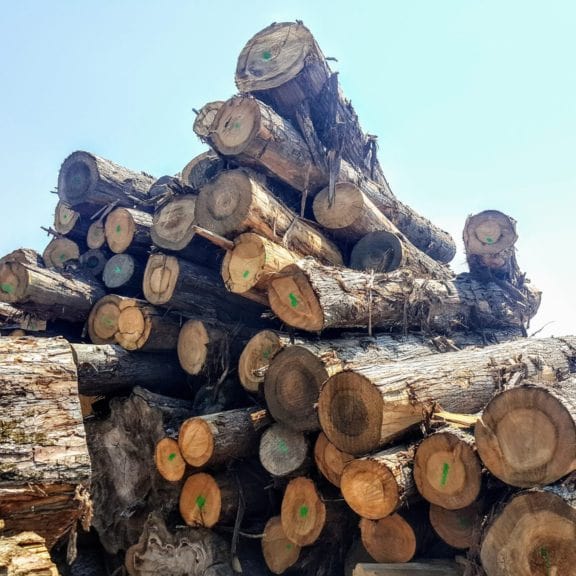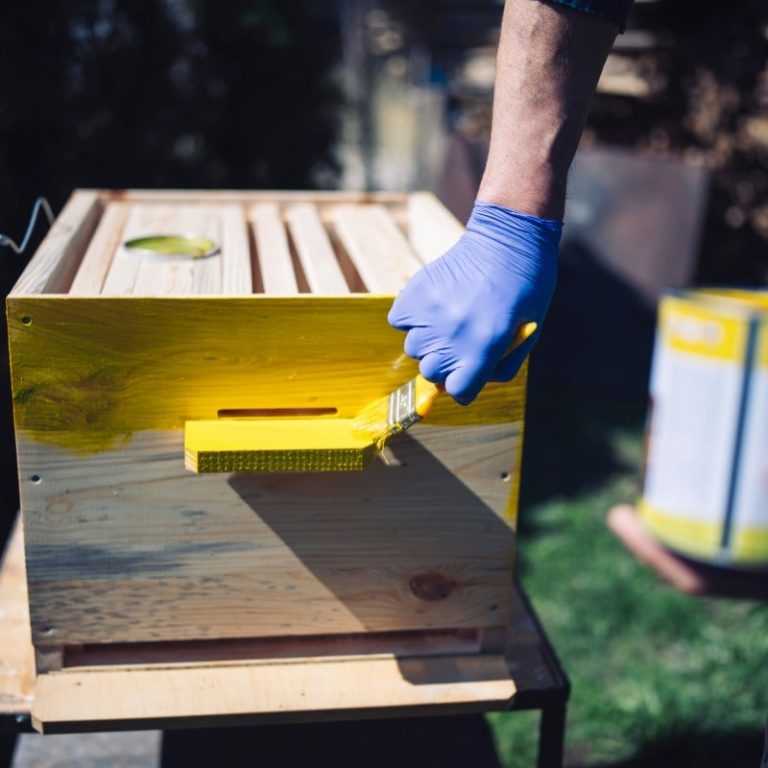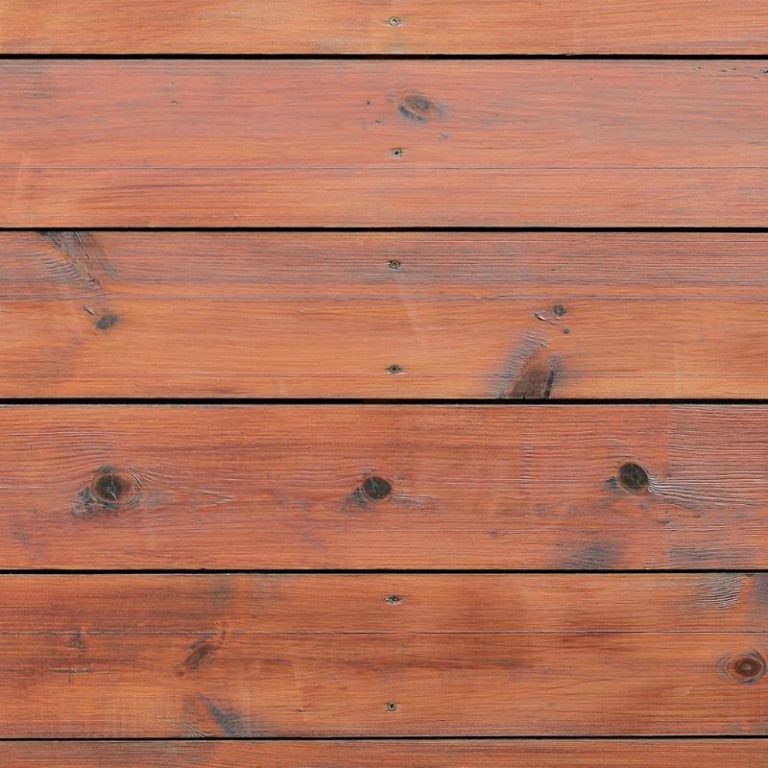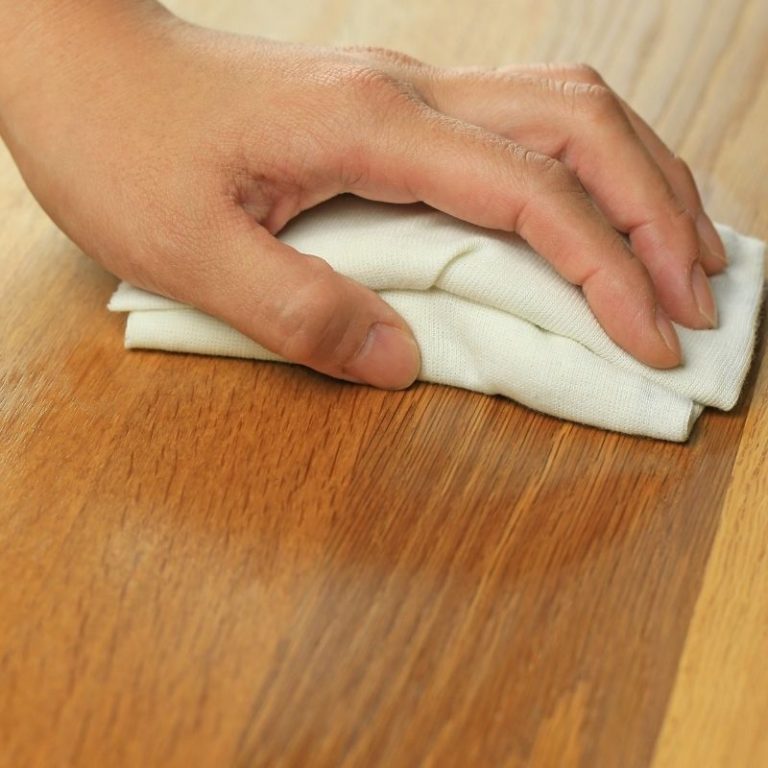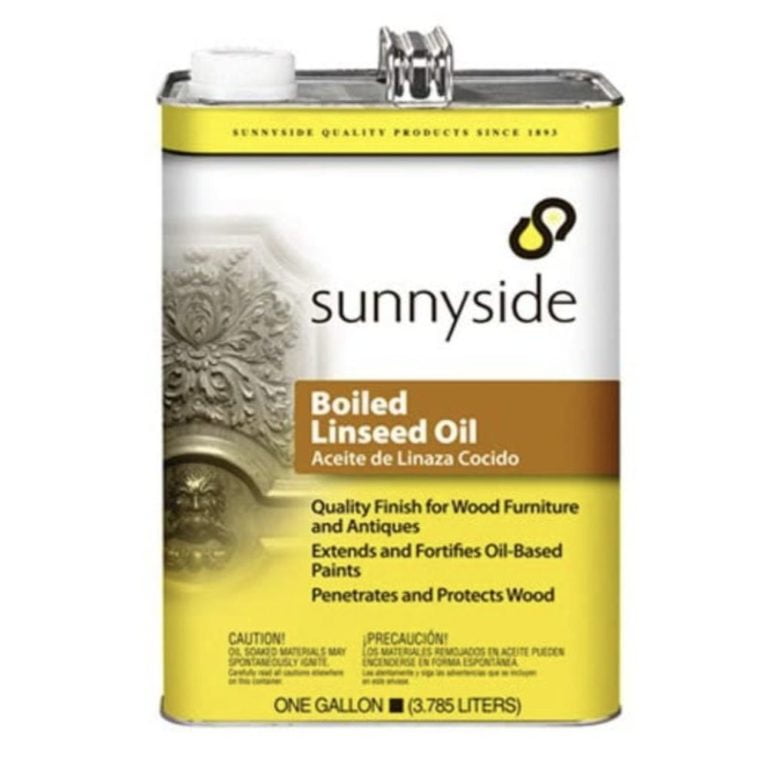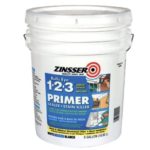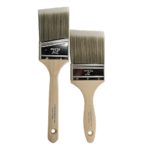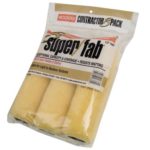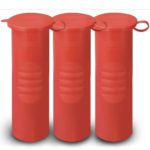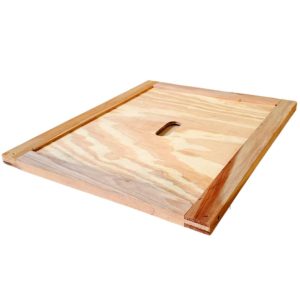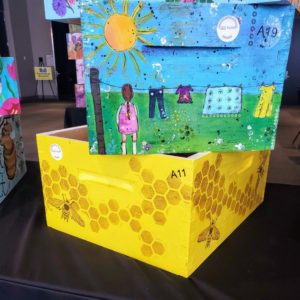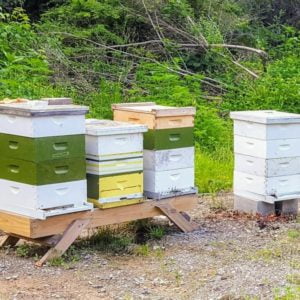

So you are excited about getting your honey bees and need to get your equipment ready. This post covers all the details of getting your equipment ready for your bees. For some reason, painting beehives can be made into something difficult.
But painting beekeeping equipment is incredibly easy. It’s best to paint your equipment so that you can get more years out of your equipment without much effort. And it’s easier without bees in it as well.
But from the hive stand to the telescoping cover, we will explain it.
Other ways to protect the finish include oil-based paint, stains, oils, and even wax dipping. They all have their advantages and disadvantages. You pick what works best for you and your bees, and we talk about them below.
Painting your bee equipment isn’t just about the finish; the technique is nearly as important as choosing the right finish.
So you are excited about getting your honey bees and need to get your equipment ready. This post covers all the details of getting your equipment ready for your bees. For some reason, painting beehives can be made into something difficult.
But painting beekeeping equipment is incredibly easy. It’s best to paint your equipment so that you can get more years out of your equipment without much effort. And it’s easier without bees in it as well.
But from the hive stand to the telescoping cover, we will explain it.
Other ways to protect the finish include oil-based paint, stains, oils, and even wax dipping. They all have their advantages and disadvantages. You pick what works best for you and your bees, and we talk about them below.
Painting your bee equipment isn’t just about the finish; the technique is nearly as important as choosing the right finish.
Table of Contents
Table of Contents
Regardless of which option you choose to finish your hive, make sure you use a high quality exterior wood glue like Titebond 3 and quality nails or screws before finishing your hive boxes and other equipment
Foxhound Bee Co
Tweet
Regardless of which option you choose to finish your hive, make sure you use a high quality exterior wood glue like Titebond 3 and quality nails or screws before finishing your hive boxes and other equipment
Foxhound Bee Co
Tweet
Should I Paint My Beehives?
Should I Paint My Beehives?
So when you first get your hives, you may wonder if you need to paint your equipment at all. It depends on a few things.
Most beekeeping supply companies make all their equipment out of pinewood, a cheap and easily grown wood. Pine is what every 2×4 board is made from and is the most common tree used for beekeeping supplies. There are different pine species available, like sugar pine, eastern/western white pine, ponderosa, red, and many others. They are all made from pine trees and have similar characteristics.
But they all rot fairly quickly when compared to other species of wood. They are very soft wood and absorb water quickly, which leads to quick rot. If using pine wood for beehives, it needs to be painted or be prepared to replace it in a few years.
The other types of wood that are commonly used for beehives are cedarwood and cypress wood. Cypress wood is common in the southeastern United States, and cedar is common in the western United States. Both are naturally rot-resistant and also resistant to insects chewing on them.
Both cypress and cedar wood are great for beehives because they are naturally durable if a beekeeper doesn’t want to paint them but last even longer if painting or finishing. If you want to know more about comparing cypress and pine wood, read more here about cypress wood for beehives.
So when you first get your hives, you may wonder if you need to paint your equipment at all. It depends on a few things.
Most beekeeping supply companies make all their equipment out of pinewood, a cheap and easily grown wood. Pine is what every 2×4 board is made from and is the most common tree used for beekeeping supplies. There are different pine species available, like sugar pine, eastern/western white pine, ponderosa, red, and many others. They are all made from pine trees and have similar characteristics.
But they all rot fairly quickly when compared to other species of wood. They are very soft wood and absorb water quickly, which leads to quick rot. If using pine wood for beehives, it needs to be painted or be prepared to replace it in a few years.
The other types of wood that are commonly used for beehives are cedarwood and cypress wood. Cypress wood is common in the southeastern United States, and cedar is common in the western United States. Both are naturally rot-resistant and also resistant to insects chewing on them.
Both cypress and cedar wood are great for beehives because they are naturally durable if a beekeeper doesn’t want to paint them but last even longer if painting or finishing. If you want to know more about comparing cypress and pine wood, read more here about cypress wood for beehives.
It’s best to paint equipment before the bees go into the hive, but you certainly can paint the hives while the bees are in it in the bee yard. But it is a little harder, and it needs to be cold enough where the bees aren’t flying and warm enough for the paint to dry.
-Foxhound Bee Co
Tweet
It’s best to paint equipment before the bees go into the hive, but you certainly can paint the hives while the bees are in it in the bee yard. But it is a little harder, and it needs to be cold enough where the bees aren’t flying and warm enough for the paint to dry.
-Foxhound Bee Co
Tweet
The Best Finish For Beekeeping Equipment
The Best Finish For Beekeeping Equipment
Protecting your bee equipment from the weather is, without a doubt, one of the best ways a beekeeper can take care of their supplies. There are many options for painting bee supplies, and they aren’t all created equal. No finish is perfect for every beekeeper, and depending on your goal for beekeeping, you’ll choose a different finish.
The guide below is true for brood boxes, honey supers, medium boxes, deep boxes, telescoping covers, hives stands, and bottom boards. Commercial beekeepers don’t care much about the paint finish because they typically sell their equipment after a few years and buy new. So commercial beekeepers may not paint their equipment at all.
But a backyard beekeeper who looks at their hives nearly every day may want a better finish for their hives. Something that protects the wood but also looks really good.
Types of finishes, ordered from best to worst
The absolute best, but hard to get – Wax dipped cypress wood
Best Protection – Exterior latex paint and primer
Good Protection – Deck stains with UV Inhibitors
Less Protection- Oil finishes like boiled linseed oil
Least Protective – Unfinished raw wood
Protecting your bee equipment from the weather is, without a doubt, one of the best ways a beekeeper can take care of their supplies. There are many options for painting bee supplies, and they aren’t all created equal. No finish is perfect for every beekeeper, and depending on your goal for beekeeping, you’ll choose a different finish.
The guide below is true for brood boxes, honey supers, medium boxes, deep boxes, telescoping covers, hives stands, and bottom boards. Commercial beekeepers don’t care much about the paint finish because they typically sell their equipment after a few years and buy new. So commercial beekeepers may not paint their equipment at all.
But a backyard beekeeper who looks at their hives nearly every day may want a better finish for their hives. Something that protects the wood but also looks really good.
Types of finishes, ordered from best to worst
The absolute best, but hard to get – Wax dipped cypress wood
Best Protection – Exterior latex paint and primer
Good Protection – Deck stains with UV Inhibitors
Less Protection- Oil finishes like boiled linseed oil
Least Protective – Unfinished raw wood
Latex (Water Based Paint)
Latex (Water Based Paint)
Latex (also called water-based) paint is the most common finish for beehives because it is the cheapest and most available paint type. Exterior latex paint is also popular because it’s straightforward to clean up, and you can find a quality that fits your budget. Remember, when buying paint you typically get what you pay for.
If you are looking for the best brand of exterior paint for your paint job, we don’t know it. Every brand has high and low quality options.
Buying the cheapest paint quality usually does not pay off, and the finish does not look good. The very cheap paint doesn’t hide or cover well. It’s like when someone adds water to the last bit of soap in the bottle. It’s just not worth it.
It’s a much better choice to buy the mid-grade paint or the best quality if you can swing it. But let’s be real; it’s a beehive, not the Mona Lisa. Mid-grade paint is good enough for most beekeepers. (A note here), when we paint hives for customers, we use really great quality primer and really great quality exterior finish. We spring for the good stuff because we want our equipment to look good when customers pick it up.
Many beekeepers buy the “mistake” or “oops” paint that has been returned to the store. If you don’t know, there is typically a rack of paint that has been returned because of a color error and is sold at a discount. Scoop this paint up and use it on your hives. Whichever color you choose, make sure it is exterior paint. The bees don’t care about the color of your paint job.
Latex (also called water-based) paint is the most common finish for beehives because it is the cheapest and most available paint type. Exterior latex paint is also popular because it’s straightforward to clean up, and you can find a quality that fits your budget. Remember, when buying paint you typically get what you pay for.
If you are looking for the best brand of exterior paint for your paint job, we don’t know it. Every brand has high and low quality options.
Buying the cheapest paint quality usually does not pay off, and the finish does not look good. The very cheap paint doesn’t hide or cover well. It’s like when someone adds water to the last bit of soap in the bottle. It’s just not worth it.
It’s a much better choice to buy the mid-grade paint or the best quality if you can swing it. But let’s be real; it’s a beehive, not the Mona Lisa. Mid-grade paint is good enough for most beekeepers. (A note here), when we paint hives for customers, we use really great quality primer and really great quality exterior finish. We spring for the good stuff because we want our equipment to look good when customers pick it up.
Many beekeepers buy the “mistake” or “oops” paint that has been returned to the store. If you don’t know, there is typically a rack of paint that has been returned because of a color error and is sold at a discount. Scoop this paint up and use it on your hives. Whichever color you choose, make sure it is exterior paint. The bees don’t care about the color of your paint job.
Two painted surfaces will stick to each other, so it isn’t necessary to paint the top and bottom edges of boxes. But if you want to, go for it. Not a big deal, so do your thing.
Two painted surfaces will stick to each other, so it isn’t necessary to paint the top and bottom edges of boxes. But if you want to, go for it. Not a big deal, so do your thing.
Two painted surfaces will stick to each other, so it isn’t necessary to paint the top and bottom edges of boxes. But if you want to, go for it. Not a big deal, so do your thing.
Two painted surfaces will stick to each other, so it isn’t necessary to paint the top and bottom edges of boxes. But if you want to, go for it. Not a big deal, so do your thing.
Oil-Based Paint For Beehives
Oil-Based Paint For Beehives
This is the sibling to water-based or latex paint. Oil based exterior primer or paint works very well. However, it isn’t easy to clean up after. You have to use special cleaners like mineral spirits if you want to reuse the brush or the roller.
Oil-based paints are tougher and hold up better to wear and tear compared to latex paint. Then again, the additional effort required for cleanup may not make it worth the hassle.
The visual finish of an oil-based beehive is the same as a latex-based finish but with more hassle. So don’t opt for it unless you already have it on hand and need to use it up.
Traditionally, you would use oil-based paint for certain types of woods that have high acid levels. Cypress wood is one of these. As a beekeeping supplier focused on cypress equipment, this is how we started painting our hives.
We have since switched to water-based paint. So far, we have not seen any issues with the wood bleeding through the paint and do not plan to use oil-based paint again.pri
This is the sibling to water-based or latex paint. Oil based exterior primer or paint works very well. However, it isn’t easy to clean up after. You have to use special cleaners like mineral spirits if you want to reuse the brush or the roller.
Oil-based paints are tougher and hold up better to wear and tear compared to latex paint. Then again, the additional effort required for cleanup may not make it worth the hassle.
The visual finish of an oil-based beehive is the same as a latex-based finish but with more hassle. So don’t opt for it unless you already have it on hand and need to use it up.
Traditionally, you would use oil-based paint for certain types of woods that have high acid levels. Cypress wood is one of these. As a beekeeping supplier focused on cypress equipment, this is how we started painting our hives.
We have since switched to water-based paint. So far, we have not seen any issues with the wood bleeding through the paint and do not plan to use oil-based paint again.pri
Stains For Beehives
Stains For Beehives
Stains get the gold star for being versatile. This is because they can protect your wood but also keep the grain showing. In general, the darker the stain, the better it will protect your wood. This is because the stain’s pigments help block the UV rays, ultimately breaking down the finish.
The enemy of wood is moisture and UV-rays. Both will wear down your equipment over time. When we teach classes, we tell students that if they want to protect their hives and keep the hives’ wood look, then go with a stain.
Specifically, get a stain that is designed to be used on decks. The stains designed for decks are readily available and come in a lot of different colors and qualities. You can choose the quality that fits your budget and the color that works best for you.
These stains are designed to be used in areas hit hard by the sun and the rain. They include a lot of waterproofing and UV protection. You can get them in water-based as well as oil-based types.
Stains get the gold star for being versatile. This is because they can protect your wood but also keep the grain showing. In general, the darker the stain, the better it will protect your wood. This is because the stain’s pigments help block the UV rays, ultimately breaking down the finish.
The enemy of wood is moisture and UV-rays. Both will wear down your equipment over time. When we teach classes, we tell students that if they want to protect their hives and keep the hives’ wood look, then go with a stain.
Specifically, get a stain that is designed to be used on decks. The stains designed for decks are readily available and come in a lot of different colors and qualities. You can choose the quality that fits your budget and the color that works best for you.
These stains are designed to be used in areas hit hard by the sun and the rain. They include a lot of waterproofing and UV protection. You can get them in water-based as well as oil-based types.
What Color Should I Paint A Beehive?
What Color Should I Paint A Beehive?
Traditionally, beehives are painted white. So why do most beekeepers paint their hives white? It’s probably because everybody else paints their hives white. The good news is that you can paint them whatever color you want. There are a couple of exceptions to this, though. For example, if I kept hives in Arizona and summer temps regularly reached the high 90°s and 100°s, it’s probably not the best idea to paint a hive black. But if you aren’t in those temperatures, darker colors are just fine on a hive.
So paint your beehives whichever color you’d like and have some fun with them. If you want to paint something fun like in these pictures, go with a primer coat, a coat of white latex paint, and all the fun colors. That way, it’s protected from the elements well but still looks fun.
One last thing on the fun finishes. If painting multiple boxes, keep in mind the boxes will be moved around to different hives and rotated over the years. So if you paint one image that spreads over the face of multiple boxes, keep in mind the sides may not always match up. So you may consider painting a design that doesn’t spread across multiple boxes.
Traditionally, beehives are painted white. So why do most beekeepers paint their hives white? It’s probably because everybody else paints their hives white. The good news is that you can paint them whatever color you want. There are a couple of exceptions to this, though. For example, if I kept hives in Arizona and summer temps regularly reached the high 90°s and 100°s, it’s probably not the best idea to paint a hive black. But if you aren’t in those temperatures, darker colors are just fine on a hive.
So paint your beehives whichever color you’d like and have some fun with them. If you want to paint something fun like in these pictures, go with a primer coat, a coat of white latex paint, and all the fun colors. That way, it’s protected from the elements well but still looks fun.
One last thing on the fun finishes. If painting multiple boxes, keep in mind the boxes will be moved around to different hives and rotated over the years. So if you paint one image that spreads over the face of multiple boxes, keep in mind the sides may not always match up. So you may consider painting a design that doesn’t spread across multiple boxes.
10 Tips For Painting Your Beekeeping Equipment
10 Tips For Painting Your Beekeeping Equipment
- Don’t paint the inside. Paint has chemicals that can interfere with bees’ communication. Also, it isn’t necessary to protect that wood as it isn’t exposed to the environment. Bees will coat the inside of the hive with wax and propolis and protect it themselves.
- Paint what the rain and sun will touch. This is what is most susceptible to rot.
- Buy a good primer and the mistake paint at the store. The mistake paint is the paint that the store has returned to them from a customer, and they sell it at a discount.
- Pay special attention to the joints. The joints on the wood are the most susceptible to rot as they will absorb moisture easily. They also absorb paint quickly, so apply lots of paint to protect them.
- Paint the boxes by stacking them up on top of each other. Paint the handles first, then paint the edges of the boxes. You will not be able to paint the top and bottom edges of the box, but that isn’t necessary.
- Paint the boxes by threading assembled boxes (without frames) onto a 2×4 board suspended from sawhorses. Then paint and rotate the boxes, painting each side as you rotate it.
- Use a 1/2-inch or 3/4-inch nap roller to paint the boxes. These naps do a great job at getting into the joints of the boxes.
- Paint the handholds of the box first, then paint the flat surfaces.
- Just skip spraying the equipment if you have a sprayer. Sprayers don’t work well for bottom boards or telescoping covers, but they do work well for spraying stacked boxes. But so does rolling.
- Don’t paint the top and bottom edges of boxes; they will stick together more when you do this.
- Don’t paint the inside. Paint has chemicals that can interfere with bees’ communication. Also, it isn’t necessary to protect that wood as it isn’t exposed to the environment. Bees will coat the inside of the hive with wax and propolis and protect it themselves.
- Paint what the rain and sun will touch. This is what is most susceptible to rot.
- Buy a good primer and the mistake paint at the store. The mistake paint is the paint that the store has returned to them from a customer, and they sell it at a discount.
- Pay special attention to the joints. The joints on the wood are the most susceptible to rot as they will absorb moisture easily. They also absorb paint quickly, so apply lots of paint to protect them.
- Paint the boxes by stacking them up on top of each other. Paint the handles first, then paint the edges of the boxes. You will not be able to paint the top and bottom edges of the box, but that isn’t necessary.
- Paint the boxes by threading assembled boxes (without frames) onto a 2×4 board suspended from sawhorses. Then paint and rotate the boxes, painting each side as you rotate it.
- Use a 1/2-inch or 3/4-inch nap roller to paint the boxes. These naps do a great job at getting into the joints of the boxes.
- Paint the handholds of the box first, then paint the flat surfaces.
- Just skip spraying the equipment if you have a sprayer. Sprayers don’t work well for bottom boards or telescoping covers, but they do work well for spraying stacked boxes. But so does rolling.
- Don’t paint the top and bottom edges of boxes; they will stick together more when you do this.
Boiled Linseed Oil Or Tung Oil For Beehives
Boiled Linseed Oil Or Tung Oil For Beehives
There are a lot of options for protecting your beehives more traditionally. Linseed oil is a king among them. These oils lack the UV-protection of stains, but they are certainly a beautiful way to protect the wood. We love using boiled linseed oil or tung oil for giving the wood a little bit of protection from the weather but still looking beautiful. If you have equipment that has a really nice grain to the wood, these oils are a great way to go.
Boiled linseed oil is the one you want for beehives. If the linseed is “boiled,” it has products in it that make it dry quickly. This is the most common type of linseed oil and without these products added, it would take weeks between coats.
When we use boiled linseed oil, we use 4 coats.
The first coat is 50/50 linseed oil and mineral spirits.
The second is 75% linseed oil and 25% mineral spirits.
The 3rd coat is 90% linseed oil and 10% mineral spirits.
The final coat is 100% or nearly 100% linseed oil.
The addition of the mineral spirits helps the oil to penetrate the wood better. 100% linseed oil can be hard to penetrate the wood and prevent additional coats from penetrating much at all.
There are a lot of options for protecting your beehives more traditionally. Linseed oil is a king among them. These oils lack the UV-protection of stains, but they are certainly a beautiful way to protect the wood. We love using boiled linseed oil or tung oil for giving the wood a little bit of protection from the weather but still looking beautiful. If you have equipment that has a really nice grain to the wood, these oils are a great way to go.
Boiled linseed oil is the one you want for beehives. If the linseed is “boiled,” it has products in it that make it dry quickly. This is the most common type of linseed oil and without these products added, it would take weeks between coats.
When we use boiled linseed oil, we use 4 coats.
The first coat is 50/50 linseed oil and mineral spirits.
The second is 75% linseed oil and 25% mineral spirits.
The 3rd coat is 90% linseed oil and 10% mineral spirits.
The final coat is 100% or nearly 100% linseed oil.
The addition of the mineral spirits helps the oil to penetrate the wood better. 100% linseed oil can be hard to penetrate the wood and prevent additional coats from penetrating much at all.
Boiled linseed oil available on Amazon
Second to linseed oil is tung oil, which works the same as linseed oil. Both are made from plants, considered eco-friendly, and are wiped on and wiped off. When using tung oil, we use the same technique with mineral spirits.
The wood actually has to absorb the oil into it. So you can put a lot of coats on the wood, and the more coats put on, the darker the wood will get. Be advised, though, the oil is wiped onto the wood and allowed about 15 minutes to soak in before being wiped off. Anything that doesn’t soak in needs to be wiped off, or it will become very gummy. Multiple coats are added on top, but the surface oil can’t be allowed to “dry.”
Twitter
LinkedIn
Facebook
Pinterest
StumbleUpon
Reddit
We built a 10′ Alabama out of bee boxes and finished it with tung oil. If you want to see how we made it and finished it, click here.
Boiled linseed oil available on Amazon
Second to linseed oil is tung oil, which works the same as linseed oil. Both are made from plants, considered eco-friendly, and are wiped on and wiped off. When using tung oil, we use the same technique with mineral spirits.
The wood actually has to absorb the oil into it. So you can put a lot of coats on the wood, and the more coats put on, the darker the wood will get. Be advised, though, the oil is wiped onto the wood and allowed about 15 minutes to soak in before being wiped off. Anything that doesn’t soak in needs to be wiped off, or it will become very gummy. Multiple coats are added on top, but the surface oil can’t be allowed to “dry.”
Twitter
LinkedIn
Facebook
Pinterest
StumbleUpon
Reddit
We built a 10′ Alabama out of bee boxes and finished it with tung oil. If you want to see how we made it and finished it, click here.
What Parts Of Bee Equipment Do I Need To Paint?
What Parts Of Bee Equipment Do I Need To Paint?
The short of this is that you need to paint any part of the equipment that will get wet every time it rains. The rain and the sun break down the wood over time, and painting these surfaces ensures your equipment will last for years or even a decade before needing another coat.
Remember to assemble all your equipment before you paint it. It is much easier to do it this way.
The short of this is that you need to paint any part of the equipment that will get wet every time it rains. The rain and the sun break down the wood over time, and painting these surfaces ensures your equipment will last for years or even a decade before needing another coat.
Remember to assemble all your equipment before you paint it. It is much easier to do it this way.
Painted telescoping covers
It isn’t necessary to paint every part of the equipment. Don’t paint the inner covers, frames, or the inside of telescoping covers. The reason is that these parts aren’t exposed to the elements, so painting them isn’t necessary.
It also isn’t necessary to paint the inside of boxes. This is where bees spend much of their time, and it may not be healthy for them to be walking around the painted wood all the time. After all, paint is a chemical, and it does cost money, so it seems like a waste to paint the inside of the colony when there isn’t a risk of the wood rotting. It just isn’t necessary or worth the effort, so you can skip that part.
We have painted thousands of pieces of equipment and these are supplies that we use and recommend.
Click for more details
Painted telescoping covers
It isn’t necessary to paint every part of the equipment. Don’t paint the inner covers, frames, or the inside of telescoping covers. The reason is that these parts aren’t exposed to the elements, so painting them isn’t necessary.
It also isn’t necessary to paint the inside of boxes. This is where bees spend much of their time, and it may not be healthy for them to be walking around the painted wood all the time. After all, paint is a chemical, and it does cost money, so it seems like a waste to paint the inside of the colony when there isn’t a risk of the wood rotting. It just isn’t necessary or worth the effort, so you can skip that part.
We have painted thousands of pieces of equipment and these are supplies that we use and recommend.
Click for more details
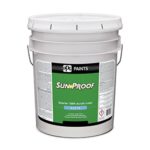
Wax Dipping Bee Hives
Wax Dipping Bee Hives
Wax dipping is a process that beekeepers use to protect their equipment from the weather. Beekeeping equipment like boxes, bottom boards, and telescoping covers are all placed in a hot vat of wax, about 220°F, and heated until the wood surfaces soak up the wax. Usually, it takes 10-15 minutes per batch. Dipping bee boxes in wax is my favorite option for protecting beehives. It protects the wood very well, is better than paint, and lasts longer.
The wax is actually cooked into the wood and displaces any water in the wood. It’s a great way to make the most out of the wood, but it is expensive to buy the equipment.
Wax dipping is typically done with a big group of beekeepers, where they get together and dip all their equipment at once. It isn’t widespread, and it is usually hard to find the service, but it is worth it if you can get it done.
Contrary to what you might believe, the equipment is actually not “cooked” in beeswax but actually a mixture of paraffin and microcrystalline. The combination of waxes helps the wood be protected very well for a very long time in all weather climates. Plus, the wood maintains its natural color.
Wax dipping is a process that beekeepers use to protect their equipment from the weather. Beekeeping equipment like boxes, bottom boards, and telescoping covers are all placed in a hot vat of wax, about 220°F, and heated until the wood surfaces soak up the wax. Usually, it takes 10-15 minutes per batch. Dipping bee boxes in wax is my favorite option for protecting beehives. It protects the wood very well, is better than paint, and lasts longer.
The wax is actually cooked into the wood and displaces any water in the wood. It’s a great way to make the most out of the wood, but it is expensive to buy the equipment.
Wax dipping is typically done with a big group of beekeepers, where they get together and dip all their equipment at once. It isn’t widespread, and it is usually hard to find the service, but it is worth it if you can get it done.
Contrary to what you might believe, the equipment is actually not “cooked” in beeswax but actually a mixture of paraffin and microcrystalline. The combination of waxes helps the wood be protected very well for a very long time in all weather climates. Plus, the wood maintains its natural color.

